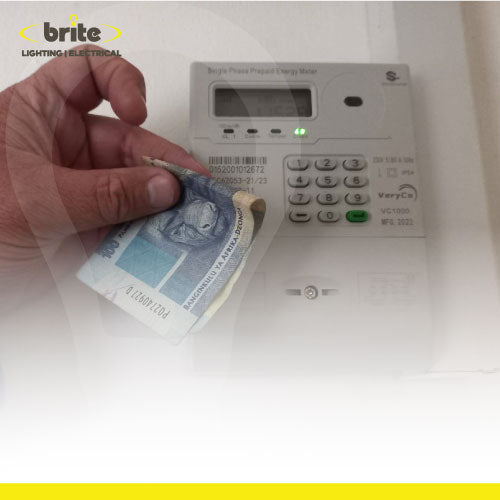
A Brighter Choice: Everything You Need to Know About Installing a Prepaid Electrical Meter
In a world where energy efficiency and cost savings are paramount, many consumers are seeking alternative ways to manage their electricity consumption. For consumers in South Africa, upgrading from traditional Eskom installed meters to prepaid electrical meters is a practical and financially savvy solution.
This article aims to guide consumers through the process of installing a prepaid electric meter, highlighting the benefits and steps involved.
Understanding Prepaid Electrical Meters:
Prepaid electric meters offer consumers greater control over their electricity usage and expenditure. Unlike conventional meters, which are typically installed by Eskom, prepaid meters allow users to pay for electricity in advance. This not only helps in budgeting but also eliminates the surprise of hefty bills at the end of the month.
How do prepaid meters work?
Prepaid electric meters in South Africa operate on a pay-as-you-go system, allowing users to purchase electricity credits in advance and use them until the credit is depleted. Here is an overview of how prepaid electric meters work in South Africa:
1. Meter Installation:
Prepaid meters are installed either by Eskom or any other electrician. The installation process involves connecting the meter to the electrical supply of the premises, and registering the meter with Eskom.
2. Meter Types:
Prepaid meters come in various types, including traditional keypad meters and more advanced smart meters. Traditional keypad meters require users to input a token or code manually, while smart meters may support online top-ups, mobile apps, and remote monitoring.
3. Purchase of Electricity Credits:
Users can purchase electricity credits (prepaid tokens or vouchers) in advance from various authorised outlets. These outlets include local convenience stores, supermarkets, online platforms - like banking profiles, or dedicated vending stations. The purchased credit is then loaded onto the prepaid meter.
4. Entering Token or Code:
For traditional keypad meters, users receive a unique code or token after purchasing electricity credits. This code is entered into the meter manually using the keypad. Smart meters may automatically update with the purchased credits after an online or mobile payment.
5. Credit and Consumption Monitoring:
The prepaid meter displays the available credit and, in some cases, provides real-time information on electricity consumption. Users can monitor their usage and adjust their habits accordingly to stay within budget.
6. Low Credit Notifications:
Prepaid meters often have features that alert users when their credit is running low. This helps consumers stay informed about their electricity balance and prompts them to top up before the electricity supply is interrupted.
7. Automatic Disconnection for Non-Payment:
If the prepaid meter runs out of credit, the electricity supply is automatically disconnected. This encourages users to manage their consumption responsibly and ensures that the prepaid system operates effectively.
8. Recharge Options:
Users have various options to recharge their prepaid meters, including online platforms, mobile apps, and physical locations. Some utility companies also provide SMS or USSD codes for convenient credit top-ups.
9. Flexibility and Control:
Prepaid meters offer consumers greater flexibility and control over their electricity usage and expenses. Users can choose how much credit to purchase based on their budget and needs.
It's important to note that the specific features and processes may vary slightly depending on the type and model of the prepaid meter used.
Benefits of Prepaid Electrical Meters:
1. Cost Control:
With a prepaid meter, users have a clear understanding of their energy consumption patterns, enabling them to manage and control costs effectively.
2. No Monthly Bills:
Prepaid meters eliminate the need for monthly bills and potential late payment fees. Consumers can simply top up their meters when needed.
3. Budget-Friendly:
The pay-as-you-go nature of prepaid meters aligns with a budget-conscious lifestyle, allowing consumers to allocate funds for electricity based on their financial capabilities.
4. Real-Time Monitoring:
Users can monitor their electricity consumption in real-time, empowering them to make informed decisions about energy usage and identify areas where energy savings can be achieved.
Disadvantages of Prepaid Meters:
While prepaid electrical meters in South Africa offer several advantages, there are also some potential disadvantages associated with this billing system. It's important to consider these factors to make an informed decision. Here are some common disadvantages of prepaid electrical meters in South Africa:
1. Higher Tariffs:
In some cases, the cost per unit of electricity for prepaid meters can be higher than that of traditional postpaid meters. This can result in higher overall costs for consumers, especially if they are unable to monitor and manage their usage effectively.
2. Inconvenience of Recharging:
Users need to actively monitor their electricity balance and recharge their meters regularly to avoid disconnection. For some consumers, this constant need for recharging can be inconvenient, especially if they forget to top up and experience sudden power interruptions.
3. Risk of Disconnection:
Prepaid meters automatically disconnect the electricity supply when the prepaid credit is depleted. While this encourages responsible energy consumption, it can be a disadvantage if users run out of credit unexpectedly, leading to interruptions in power supply.
4. Limited Access to Emergency Credit:
Traditional post-paid meters often provide consumers with emergency credit in case they are unable to pay their bills immediately. Prepaid meters may not offer the same level of flexibility, and users need to plan their credit purchases to avoid sudden interruptions.
5. Dependency on Vending Points:
Users typically need to visit specific outlets or use online platforms to recharge their prepaid meters. Limited access to vending points or technical issues with online platforms can create challenges for users, especially in remote or rural areas.
6. Installation Costs:
While the installation of prepaid meters is a one-time expense, users may incur additional costs when initially installing the meter. This can be a disadvantage for some consumers, particularly those on a tight budget.
7. Lack of Detailed Billing Information:
Prepaid meters may provide limited information on detailed usage patterns, making it challenging for consumers to identify specific appliances or behaviours contributing to high electricity consumption.
8. Potential for Price Manipulation:
In some cases, there have been concerns about potential price manipulation or price gouging by certain vendors selling prepaid electricity tokens. Consumers should be cautious and purchase from reputable sources.
9. Not Ideal for All Consumers:
Prepaid meters may not be suitable for all consumers, especially those with irregular income or those who prefer the convenience of monthly billing. Some consumers may find it challenging to manage their electricity budget effectively with a prepaid system.
It's essential for consumers to carefully evaluate their preferences and circumstances before choosing between prepaid and postpaid electricity meters. Understanding the specific terms and conditions of the prepaid system offered by Eskom is crucial to making an informed decision.
However, regardless of the disadvantages, due to the lack of infrastructure and upgrades in Eskom, nationwide, traditional post-paid meters aren't regularly maintained and calibrated to ensure accurate readings and smart meter roll-outs have been slow.
This has resulted in many nationwide consumer complaints about inaccurate readings and hefty unplanned electricity bills from Eskom.
Although the cost per unit can be more expensive with a prepaid meter, having an accurate meter that is maintained and calibrated goes a long way in ensuring consumers remain on top of their electricity charges and are able to budget their electricity usage
Installing a Prepaid Electrical Meter:
1. Choose the Right Meter:
Brite Lighting offers a range of prepaid electrical meters suitable for various needs. Select a meter that aligns with your consumption patterns and requirements.
2. Professional Installation:
While some prepaid meters are user-friendly, it's recommended to have a professional electrician to handle the installation process to ensure safety and compliance with local regulations.
3. Meter Registration:
After installation, the meter needs to be registered with Eskom to ensure that your meter is officially recognised and activated so that you don't continue to receive post-paid electricity bills.
4. Top-Up Options:
Familiarise yourself with the different top-up options available, such as online platforms, mobile apps, or physical locations.
Get a prepaid meter from Brite Lighting
Upgrading to a prepaid electrical meter from Brite Lighting is a smart and practical choice for consumers in South Africa. By understanding the benefits and following the installation process, users can take control of their electricity consumption, save costs, and contribute to a more sustainable and efficient energy future.
Brite Lighting is committed to providing top-quality products and support to ensure a seamless transition to prepaid electric meters for a brighter, cost-effective future.
